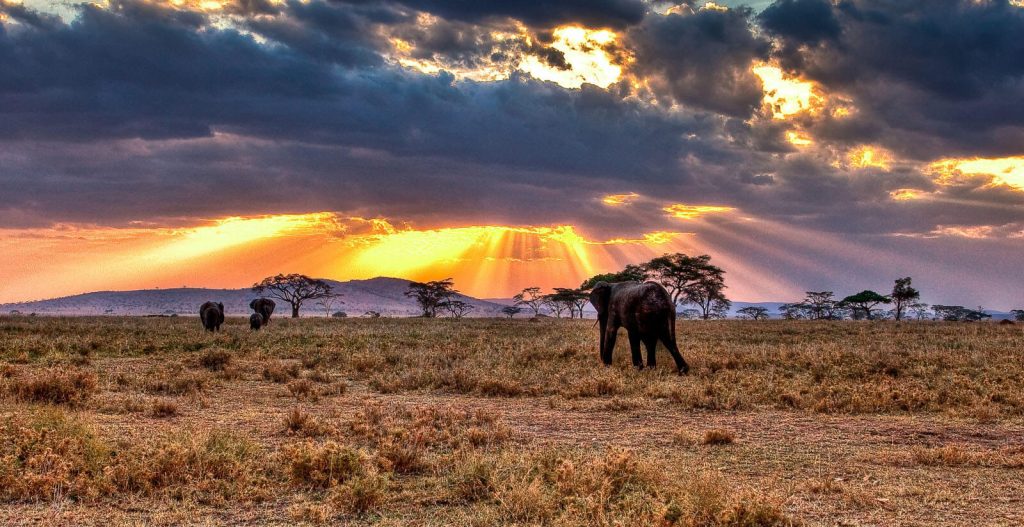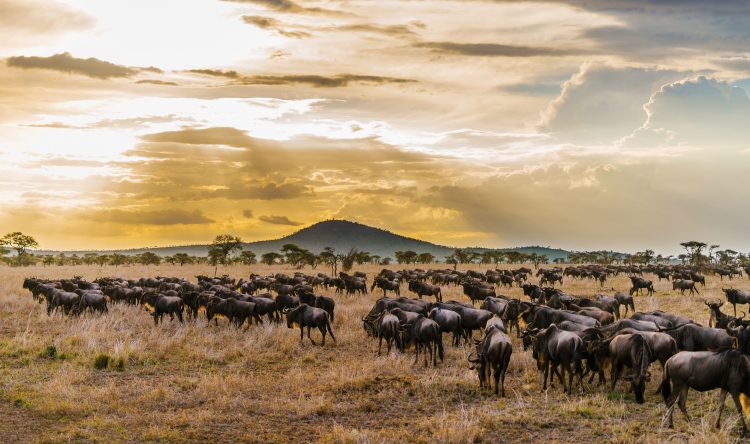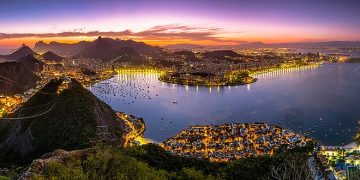In East Africa, a vast expanse south of the equator, there is a region known as the “land of eternal mobility” – the Serengeti Plain. It is not only the site of one of the most spectacular animal migrations on Earth, but also a witness to the interweaving of nature and human history. This paper will discuss the geography, history, culture, economy and other aspects of the Serengeti in detail, and dig deep into the story and significance behind it.
I. Geographical overview
The Serengeti Plain is located in eastern Africa, bordered by Kenya and Uganda to the north, Zambia, Malawi and Mozambique to the south, Rwanda, Burundi and the Democratic Republic of the Congo to the west, and the Indian Ocean to the east. The plain covers an area of about 31,080 square kilometers and covers the Serengeti National Park in Tanzania and the Masai Mara game Reserve in Kenya. The terrain of the Serengeti is complex and varied, consisting mainly of crystalline rock covered with volcanic ash, accompanied by numerous outcrops of granite hills. The northern and western panhandle are mountainous areas formed by volcanic eruptions, while the eastern coastal areas and some inland lowlands have a savanna climate, and the western interior has a tropical mountain climate.
Rainfall in the Serengeti is concentrated from November to May, with peaks in December and March and April. The average annual temperature is about 20.8 ° C, and the altitude varies from 920 to 1850 m. In this land, two westbound rivers have water all year round, as well as numerous lakes, swamps and springs, providing a valuable source of water for wildlife. The vegetation is mainly open grassland plants, the main plants include Matang, rat tail millet and other thatch, and water centipede plants grow in moist areas. In the middle of the park is a large acacia woodland grassland, hilly vegetation and dense woodland covering much of the northern part of the park.
- Historical background
The Serengeti Plain has a long history and is a witness to the long-term coexistence and evolution of human civilization and natural ecology. Tanzania is one of the birthplaces of ancient humans, and as early as BC, there was trade with Arabia, Persia and India. However, it was not until modern times that this land gradually became known to the outside world.

In the late 19th and early 20th centuries, European explorers and geographers began to explore the Serengeti region. The German geographer Oskar Bormann entered the area in 1892 and conducted expeditions during his stay in the Ngorongoro Depression. Stuart Edward White was the first Englishman to reach the northern Serengeti, arriving in the area in 1913 and making extensive expeditions and hunting trips in the ensuing years. However, these activities have also led to a collapse in the local wildlife population, especially the lion population.
In order to protect this valuable natural heritage, the United Kingdom decided to set up a game sanctuary in the Serengeti region in 1921, and gradually expanded the scope of protection. In 1929, the 228,600-hectare area of the central Serengeti was officially designated as a game reserve, followed by the establishment of a national park in 1951. Serengeti National Park is not only one of the largest wildlife reserves in Africa, but also one of the world’s most famous nature reserves. In 1959, Serengeti National Park was inscribed on the World Heritage List as part of the Serengeti-Ngorongoro Biological Reserve under UNESCO’s People and Ecology Programme.
Third, cultural characteristics
The Serengeti has not only a spectacular natural landscape, but also a unique cultural phenomenon. In this land, the Maasai are a presence to be reckoned with. The Maasai are the largest nomadic tribe in East Africa. They live as herders, live in houses made of cow dung, and wear distinctive Masai costumes and ornaments around their bodies. The cultural practices of the Maasai prohibit the consumption of wild animals, and they live in harmony with the natural environment, forming a unique ecological concept and way of life.
The Maasai refer to the Serengeti as the “land of perpetual mobility,” a name that graphically depicts the spectacular movement of animals across the land. Every year, millions of herbivores such as wildebeest, zebras and gazelles migrate from the western Serengeti to the lush waters of the north in search of water and food. This migration is not only a feast for the natural world, it is also an integral part of Maasai life. By observing the migratory habits of animals, they accumulated rich ecological knowledge and formed a unique view of nature and the universe.
Fourth, economic impact
The Serengeti is not only of great ecological value, it also has a profound impact on the local economy. As one of the most famous tourist attractions in Tanzania, Serengeti National Park attracts tourists from all over the world every year to watch the spectacular migration of animals. Tourism has become one of the important pillars of the Tanzanian economy, creating a large number of local jobs and foreign exchange earnings.
The Serengeti also promotes agriculture and animal husbandry in the surrounding areas. Despite severe restrictions on human habitation and agricultural activities within the reserve, farmers and herders in the surrounding area can still benefit from tourism. They have improved their living conditions by providing tourism services and selling handicrafts and agricultural products to increase their income.
With the growth of the global population and economic development, the Serengeti is also facing unprecedented challenges. The continuous expansion of human activities has put pressure on natural ecosystems, and the destruction and pollution of wildlife habitats have become increasingly serious problems. Climate change is also having a profound impact on the Serengeti’s ecology, leading to changes in rainfall patterns and an increase in extreme weather events. These challenges not only threaten the survival and reproduction of wildlife, but also affect the sustainable development of local economies.
The story and meaning behind it
The Serengeti is not only a showcase for natural landscapes, but also a vivid lesson in the rhythms of life and the laws of nature. In this land, the annual animal migration is one of nature’s greatest spectacles. Millions of herbivores, such as wildebeest, zebras and gazelles, migrate en masse to survive, facing difficulties and challenges across grasslands, rivers and swamps. However, it is these challenges that shape their survival instincts and adaptability, allowing them to thrive in harsh natural environments.
Animal migration is not only a survival strategy in nature, but also the embodiment of life rhythm. They migrate to find a more suitable living environment and food sources, so as to maintain the reproduction and development of the population. This migratory behavior not only shows the tenacious and indomitable spirit of life, but also reveals the ecological relationship of interdependence and restriction among species in nature.
The Serengeti also carries a profound meaning of harmonious coexistence between man and nature. The harmonious coexistence between the Maasai people and the natural environment provides us with valuable experience and inspiration. Their ecological concept and lifestyle of respecting, adapting to and protecting nature set an example for us. At the same time, the conservation and management experience of Serengeti provides us with models and ideas for reference. By strengthening international cooperation, promoting scientific and technological innovation, and improving laws and regulations, we can better protect and manage natural resources and achieve harmonious coexistence and sustainable development between man and nature.

Sixth, look to the future
In the face of the challenges and opportunities ahead, the Serengeti needs more attention and effort. First of all, we should strengthen the awareness of ecological protection and promote the construction of ecological civilization. Through strengthening publicity and education, raising public awareness of environmental protection and other ways to guide people to establish correct ecological concepts and behavior habits. At the same time, the government and all sectors of society should increase investment and support for nature reserves such as the Serengeti Plain, strengthen ecological protection and restoration, and maintain the balance and stability of natural ecosystems.
We should promote the sustainable development of tourism. Through rational planning of tourism routes, strengthening of tourism facilities and improving the quality of tourism services, more tourists will be attracted to enjoy the natural landscape and cultural heritage of the Serengeti Plain. At the same time, we should pay attention to the principle of coordinating the ecological and social benefits of tourism and avoid over-exploitation and destruction of the natural environment.
We should strengthen international cooperation and exchanges. The Serengeti is a global natural heritage and ecological resource that needs to be protected and managed by all countries. We should strengthen cooperation and exchanges with international organizations and other countries to jointly push forward the cause of global ecological civilization. By sharing experience, exchanging technology and undertaking joint projects, we can better address global environmental issues and challenges and jointly safeguard our beautiful home planet.
The Serengeti is a land of rhythms of life and laws of nature. It bears witness to the long-term coexistence and evolution of human beings and nature, and also carries our beautiful aspirations and expectations for the future. Let us work together and act together to contribute to the protection and management of this valuable natural heritage!





















